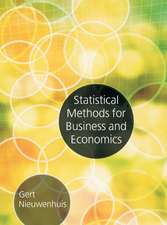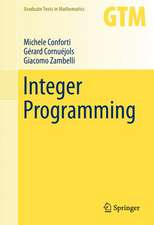Data Processing for the AHP/ANP: Quantitative Management, cartea 1
Autor Gang Kou, Daji Ergu, Yi Peng, Yong Shien Limba Engleză Paperback – 9 aug 2014
| Toate formatele și edițiile | Preț | Express |
|---|---|---|
| Paperback (1) | 379.68 lei 6-8 săpt. | |
| Springer Berlin, Heidelberg – 9 aug 2014 | 379.68 lei 6-8 săpt. | |
| Hardback (1) | 385.84 lei 6-8 săpt. | |
| Springer Berlin, Heidelberg – 26 iul 2012 | 385.84 lei 6-8 săpt. |
Preț: 379.68 lei
Nou
Puncte Express: 570
Preț estimativ în valută:
72.67€ • 78.97$ • 61.09£
72.67€ • 78.97$ • 61.09£
Carte tipărită la comandă
Livrare economică 21 aprilie-05 mai
Preluare comenzi: 021 569.72.76
Specificații
ISBN-13: 9783642433801
ISBN-10: 3642433804
Pagini: 148
Ilustrații: X, 138 p.
Dimensiuni: 155 x 235 x 8 mm
Greutate: 0.22 kg
Ediția:2013
Editura: Springer Berlin, Heidelberg
Colecția Springer
Seria Quantitative Management
Locul publicării:Berlin, Heidelberg, Germany
ISBN-10: 3642433804
Pagini: 148
Ilustrații: X, 138 p.
Dimensiuni: 155 x 235 x 8 mm
Greutate: 0.22 kg
Ediția:2013
Editura: Springer Berlin, Heidelberg
Colecția Springer
Seria Quantitative Management
Locul publicării:Berlin, Heidelberg, Germany
Public țintă
ResearchCuprins
1: Introduction.- 2: A new consistency test index for the data in the AHP/ANP.- 2.1 Basics of the AHP/ANP.- 2.1.1 The reciprocal pairwise comparison matrix.- 2.1.2 Basics of the AHP.- 2.1.3 Basics of the ANP.- 2.2 Consistency test issue in the AHP/ANP.- 2.2.1. Analysis of the consistency ratio (CR) method.- 2.2.2 The issues of consistency test in the AHP/ANP.- 2.3 The new consistency index——Maximum Eigenvalue Threshold for the AHP/ANP.- 2.3.1 The advantages of Maximum Eigenvalue Threshold for the AHP/ANP.- 2.4 The processes of data consistency test in the AHP/ANP.- 2.5. Illustrative example.- 3: IBMM for inconsistent data identification and adjustment in the AHP/ANP.- 3.1 The theorems of induced bias matrix model (IBMM) .- 3.1.1 The theoretical proofs of IBMM.- 3.2 IBMM for inconsistent data identification and adjustment.- 3.2.1 The basics of the inconsistency identification and adjustment method.- 3.2.2. The processes of inconsistency identification and adjustment method.- 3.2.3 Fast inconsistency identification and adjustment method.- 3.3. Illustrative examples.- 3.3.1 Illustrative examples for general inconsistency identification and adjustment method.- 3.3.2 Illustrative examples for fast inconsistency identification and adjustment method.- 4: IBMM for Missing Data Estimation.- 4.1 Basics of the IBMM for missing data estimation.- 4.2 The processes of estimating missing data by the IBMM.- 4.3 Proofs of the IBMM for IPCM in order three.- 4.4 Illustrative examples.- 4.4.1 Illustrative examples in order three.- 4.4.2 Illustrative examples in order four.- Chapter 5: IBMM for Questionnaire Design Improvement.- 5.1 Motivation of the research.- 5.2 The principles of improving the questionnaire design.- 5.3 Illustrative example.- Chapter 6: IBMM for rank reversal.- 6.1 Rank reversal issue in the AHP/ANP.- 6.2 Sensitivity analysis of rank reversal by the IBMM.- 6.3 Illustrative examples.- 7: Applications of IBMM.- 7.1 Task scheduling and resourceallocation in cloud computing environment by the IBMM.- 7.1.1 Resource allocation in cloud computing.- 7.1.2 Task-oriented resource allocation in cloud computing.- 7.1.3 Illustrative example.- 7.2 Risk assessment and decision analysis by the IBMM.- 7.2.1 Background of risk assessment and decision analysis.- 7.2.2 Illustrative Examples.- 8. Induced Arithmetic Average Bias Matrix Model (IAABMM).- 8.1 The theorem of IAABMM.- 8.2 The inconsistency identification processes of IAABMM.- 8.3 The estimating formula of inconsistency adjustment.- 8.4. Illustrative Examples.- References.
Recenzii
From the reviews:
“Data Processing for the AHP/ANP focuses on the induced bias matrix model and its application in the AHP / ANP. … this book might interest … researchers in the AHP / ANP or, more generally, in decision-making procedures. … The book is well organized, introduces readers to the main methodological problems in applications of AHP / ANP models, and suggests how to use the IBMM to solve them.” (Josef Jablonsky, Interfaces, Vol. 43 (5), September-October, 2013)
“Data Processing for the AHP/ANP focuses on the induced bias matrix model and its application in the AHP / ANP. … this book might interest … researchers in the AHP / ANP or, more generally, in decision-making procedures. … The book is well organized, introduces readers to the main methodological problems in applications of AHP / ANP models, and suggests how to use the IBMM to solve them.” (Josef Jablonsky, Interfaces, Vol. 43 (5), September-October, 2013)
Notă biografică
Dr. Gang Kou is a professor of School of Management and Economics, University of Electronic Science and Technology of China and managing editor of International Journal of Information Technology & Decision Making. Previously, he was a research scientist in Thomson Co., R&D. He received his Ph.D. in Information Technology from the College of Information Science & Technology, Univ. of Nebraska at Omaha; got his Master degree in Dept of Computer Science, Univ. of Nebraska at Omaha; and B.S. degree in Department of Physics, Tsinghua University, Beijing, China. He has published more than eighty papers in various peer-reviewed journals and conferences. Gang Kou has been Keynote speaker/workshop chair in several international conferences. He co-chaired Data Mining contest on The Seventh IEEE International Conference on Data Mining 2007 and he is the Program Committee Co-Chair of the 20th International Conference on Multiple Criteria Decision Making (2009) and NCM 2009: 5th International Joint Conference on INC, ICM and IDC. He is also co-editor of special issues of several journals, such as Journal of Multi Criteria Decision Analysis, Decision Support Systems, Journal of Supercomputing and Information Sciences. He accomplished more than 300 cites of published journal articles as shown in the Science Citation Index (SCI) database.
Daji Ergu, a PhD candidate in Management Science and Engineering, College of Economics & Management, University of electronic science and technology of China. He has been a lecturer of Engineering Mathematics, College of Electrical Information & Technology, Southwest University for Nationalities since 2003. Ergu’s research interests include multiple criteria decision making, risk analysis and data mining. He has published 9 papers, and 4 of which collected in SCI/EI Indexes.
Dr. Yi Peng is a Professor of School of Management and Economics, Universityof Electronic Science and Technology of China. Previously, she worked as Senior Analyst for West Co., USA. Dr. Peng received her Ph.D. in Information Technology from the College of Information Science & Technology, Univ. of Nebraska at Omaha and got her Master degree in Dept of Info. Science & Quality Assurance, Univ. of Nebraska at Omaha and B.S. degree in Department of Management Information Systems, Sichuan University, China. Dr. Peng's research interests cover Knowledge Discover in Database and data mining, multi-criteria decision making, data mining methods and modeling, knowledge discovery in real-life applications. She published more than sity papers in various peer-reviewed journals and conferences. She is the Workshop Chair of the 20th International Conference on Multiple Criteria Decision Making (2009), guest editor of Annals of Operations Research's special issue on Multiple Criteria Decision Making on Operations Research.
Dr. Yong Shi, Senior Member of IEEE, serves as the Executive Deputy Director, Chinese Academy of Sciences Research Center on Fictitious Economy & Data Science. He has been the Charles W. and Margre H. Durham Distinguished Professor of Information Technology, College of Information Science and Technology, Peter Kiewit Institute, University of Nebraska, USA since 1999. Dr. Shi's research interests include business intelligence, data mining, and multiple criteria decision making. He has published more than 17 books, over 200 papers in various journals and numerous conferences/proceedings papers. He is the Editor-in-Chief of International Journal of Information Technology and Decision Making (SCI), and a member of Editorial Board for a number of academic journals. Dr. Shi has received many distinguished awards including the Georg Cantor Award of the International Society on Multiple Criteria Decision Making (MCDM), 2009; Fudan Prize of Distinguished Contribution in Management, Fudan Premium Fund ofManagement, China, 2009; Outstanding Young Scientist Award, National Natural Science Foundation of China, 2001; and Speaker of Distinguished Visitors Program (DVP) for 1997-2000, IEEE Computer Society. He has consulted or worked on business projects for a number of international companies in data mining and knowledge management.
Daji Ergu, a PhD candidate in Management Science and Engineering, College of Economics & Management, University of electronic science and technology of China. He has been a lecturer of Engineering Mathematics, College of Electrical Information & Technology, Southwest University for Nationalities since 2003. Ergu’s research interests include multiple criteria decision making, risk analysis and data mining. He has published 9 papers, and 4 of which collected in SCI/EI Indexes.
Dr. Yi Peng is a Professor of School of Management and Economics, Universityof Electronic Science and Technology of China. Previously, she worked as Senior Analyst for West Co., USA. Dr. Peng received her Ph.D. in Information Technology from the College of Information Science & Technology, Univ. of Nebraska at Omaha and got her Master degree in Dept of Info. Science & Quality Assurance, Univ. of Nebraska at Omaha and B.S. degree in Department of Management Information Systems, Sichuan University, China. Dr. Peng's research interests cover Knowledge Discover in Database and data mining, multi-criteria decision making, data mining methods and modeling, knowledge discovery in real-life applications. She published more than sity papers in various peer-reviewed journals and conferences. She is the Workshop Chair of the 20th International Conference on Multiple Criteria Decision Making (2009), guest editor of Annals of Operations Research's special issue on Multiple Criteria Decision Making on Operations Research.
Dr. Yong Shi, Senior Member of IEEE, serves as the Executive Deputy Director, Chinese Academy of Sciences Research Center on Fictitious Economy & Data Science. He has been the Charles W. and Margre H. Durham Distinguished Professor of Information Technology, College of Information Science and Technology, Peter Kiewit Institute, University of Nebraska, USA since 1999. Dr. Shi's research interests include business intelligence, data mining, and multiple criteria decision making. He has published more than 17 books, over 200 papers in various journals and numerous conferences/proceedings papers. He is the Editor-in-Chief of International Journal of Information Technology and Decision Making (SCI), and a member of Editorial Board for a number of academic journals. Dr. Shi has received many distinguished awards including the Georg Cantor Award of the International Society on Multiple Criteria Decision Making (MCDM), 2009; Fudan Prize of Distinguished Contribution in Management, Fudan Premium Fund ofManagement, China, 2009; Outstanding Young Scientist Award, National Natural Science Foundation of China, 2001; and Speaker of Distinguished Visitors Program (DVP) for 1997-2000, IEEE Computer Society. He has consulted or worked on business projects for a number of international companies in data mining and knowledge management.
Textul de pe ultima copertă
The positive reciprocal pairwise comparison matrix (PCM) is one of the key components which is used to quantify the qualitative and/or intangible attributes into measurable quantities. This book examines six understudied issues of PCM, i.e. consistency test, inconsistent data identification and adjustment, data collection, missing or uncertain data estimation, and sensitivity analysis of rank reversal.
The maximum eigenvalue threshold method is proposed as the new consistency index for the AHP/ANP. An induced bias matrix model (IBMM) is proposed to identify and adjust the inconsistent data, and estimate the missing or uncertain data.
Two applications of IBMM including risk assessment and decision analysis, task scheduling and resource allocation in cloud computing environment, are introduced to illustrate the proposed IBMM.
The maximum eigenvalue threshold method is proposed as the new consistency index for the AHP/ANP. An induced bias matrix model (IBMM) is proposed to identify and adjust the inconsistent data, and estimate the missing or uncertain data.
Two applications of IBMM including risk assessment and decision analysis, task scheduling and resource allocation in cloud computing environment, are introduced to illustrate the proposed IBMM.
Caracteristici
A timely report of state-of-the art analytical techniques An analysis of different methods such as an induced bias matrix model (IBMM) for the data processing A method of missing item score estimation in questionnaire A proposal of inconsistency identification and adjustment A simple method for consistency test An in-depth analysis of rank reversal An in-depth illustration of two applications for induced bias matrix model (IBMM)











